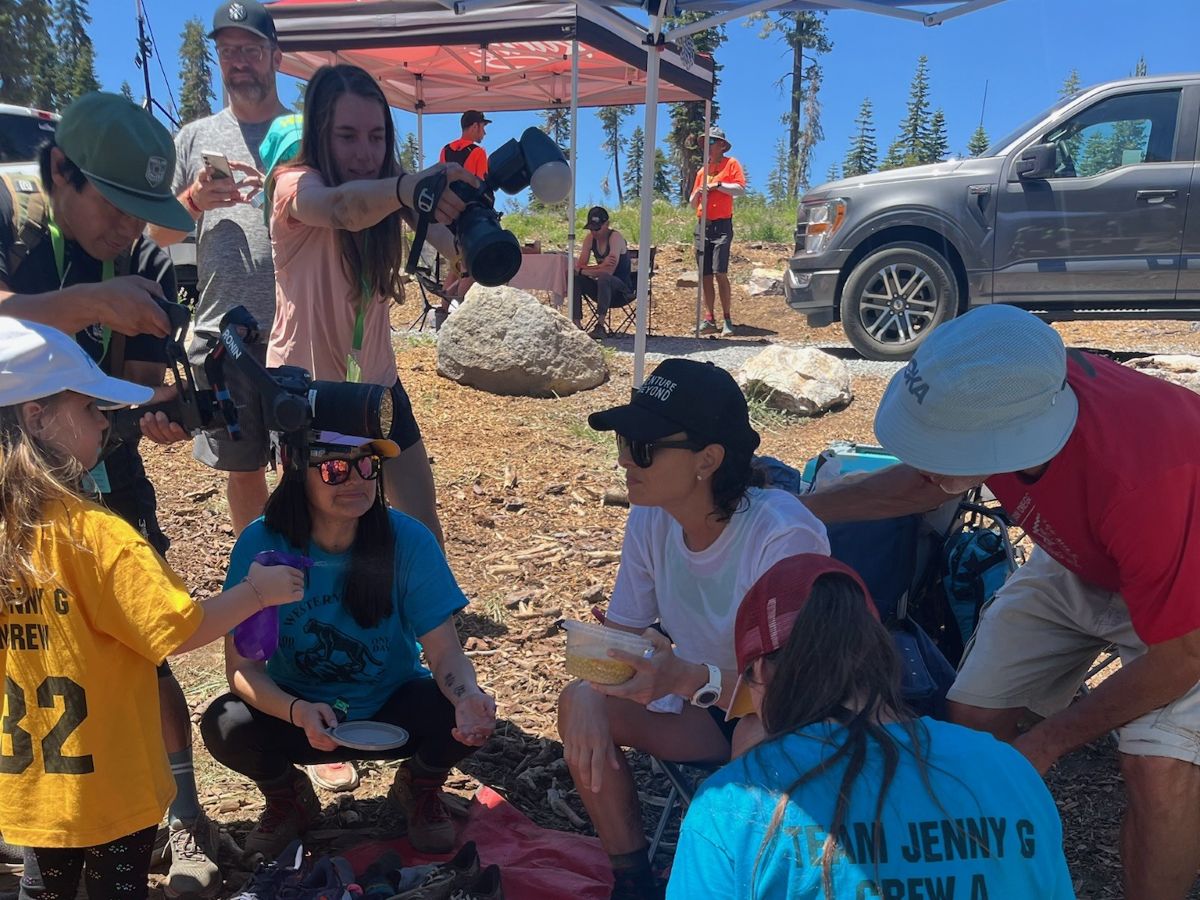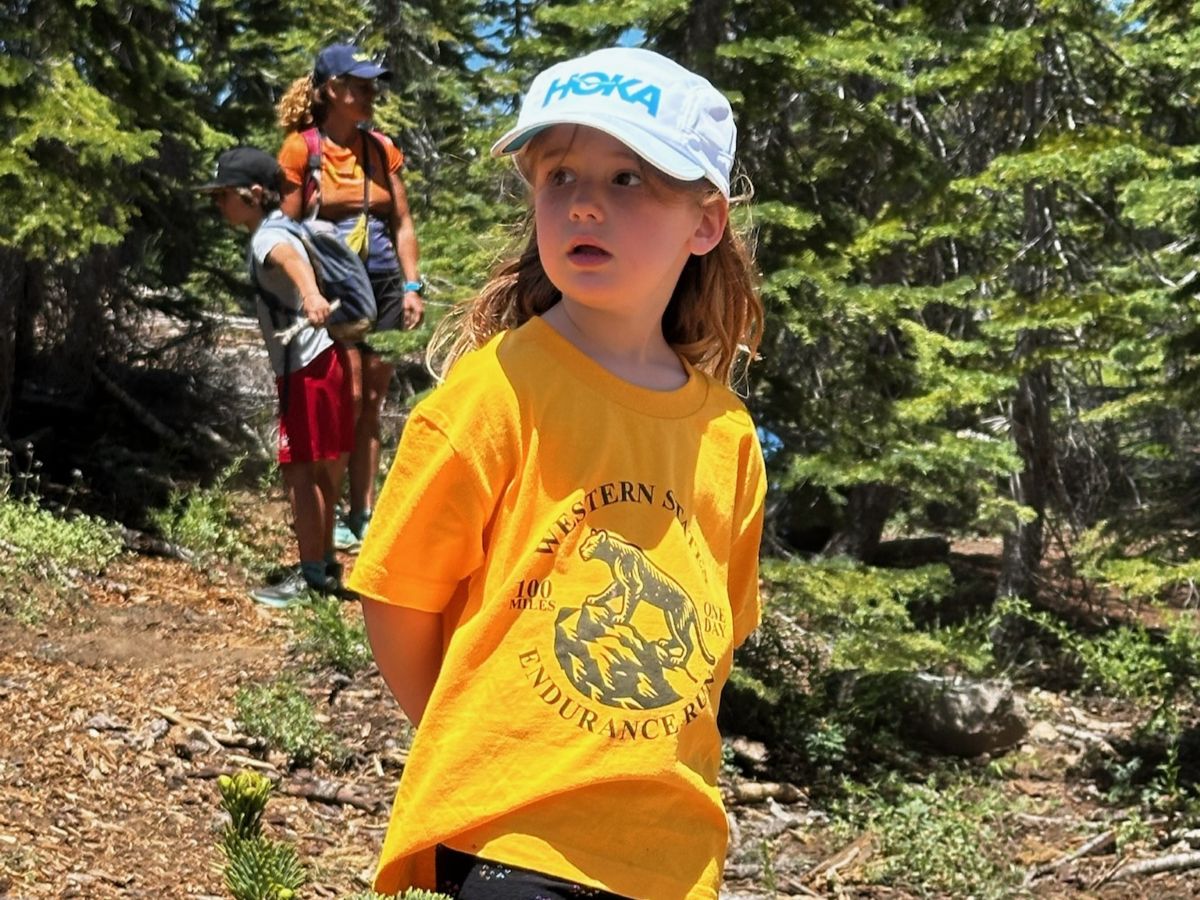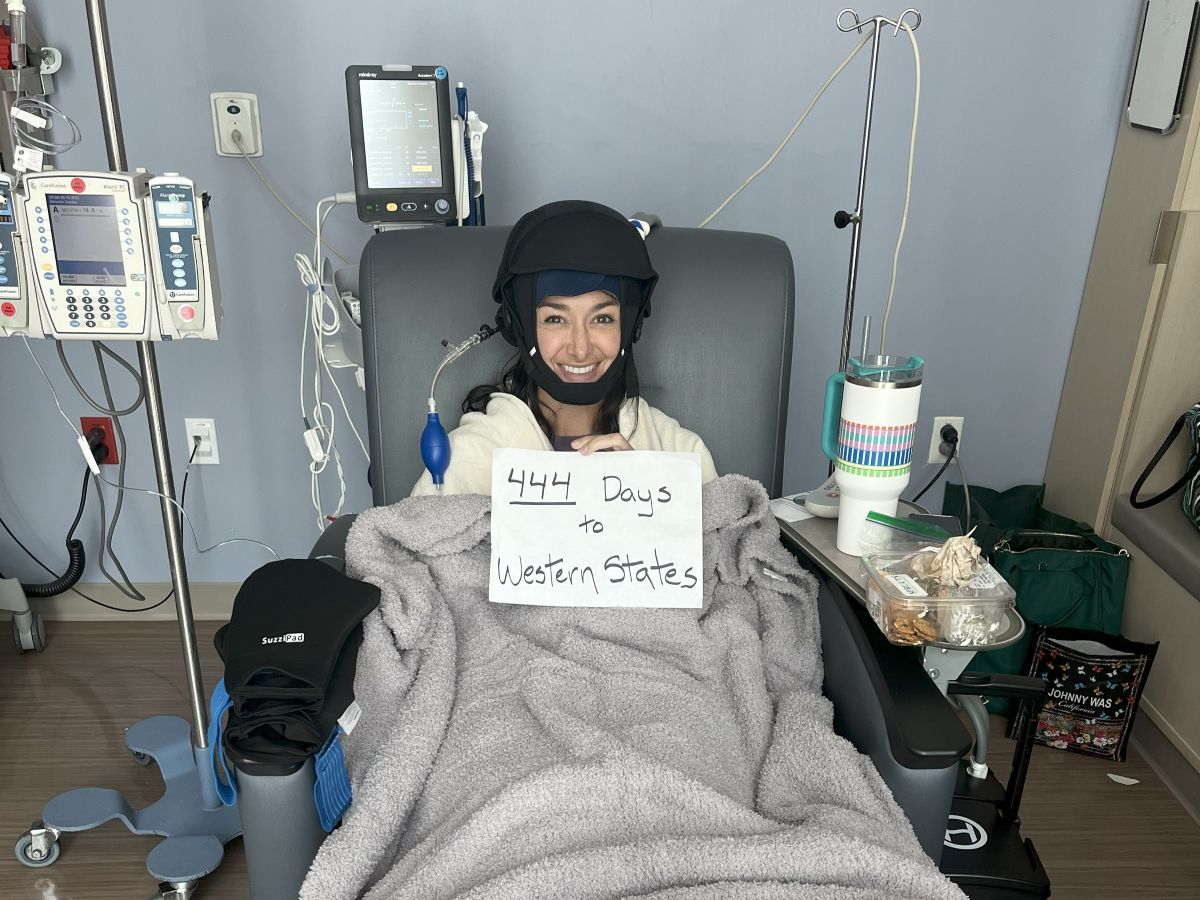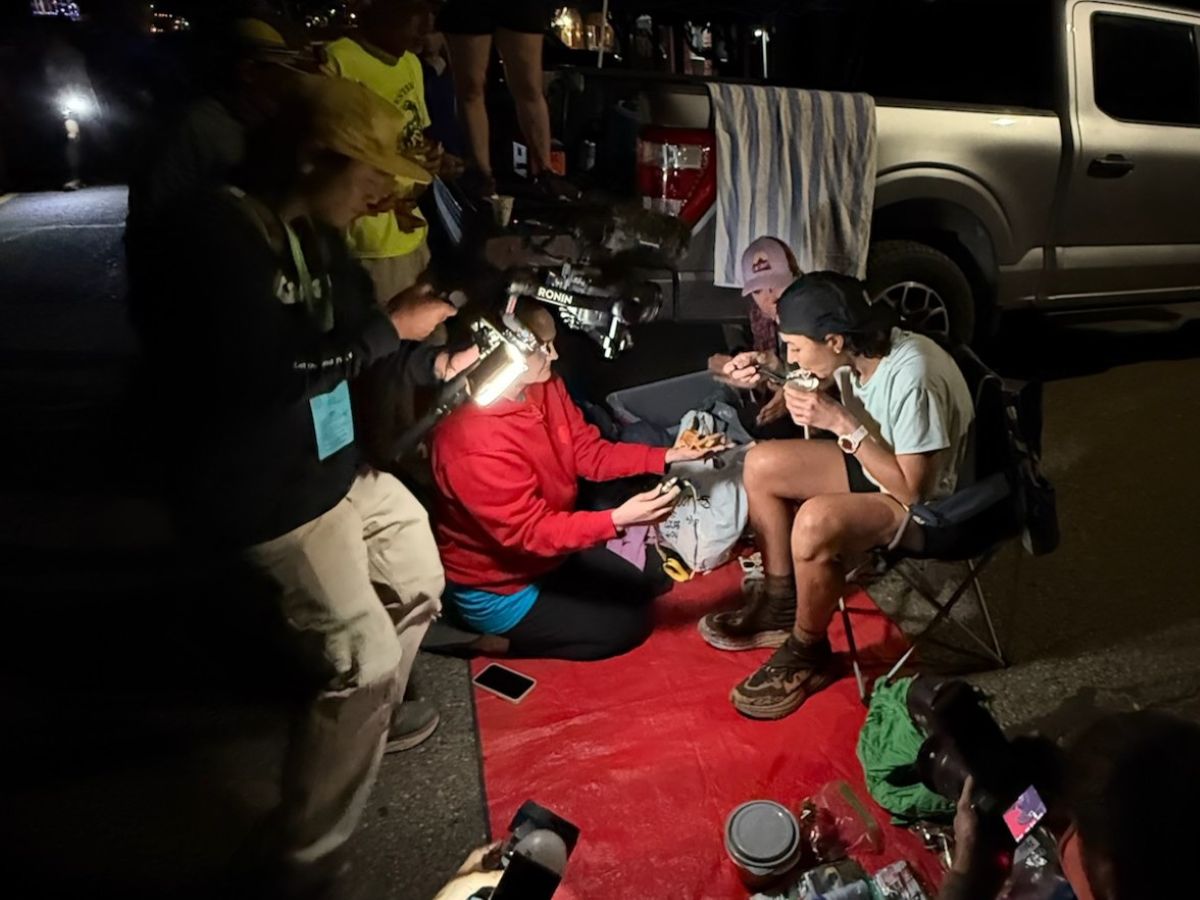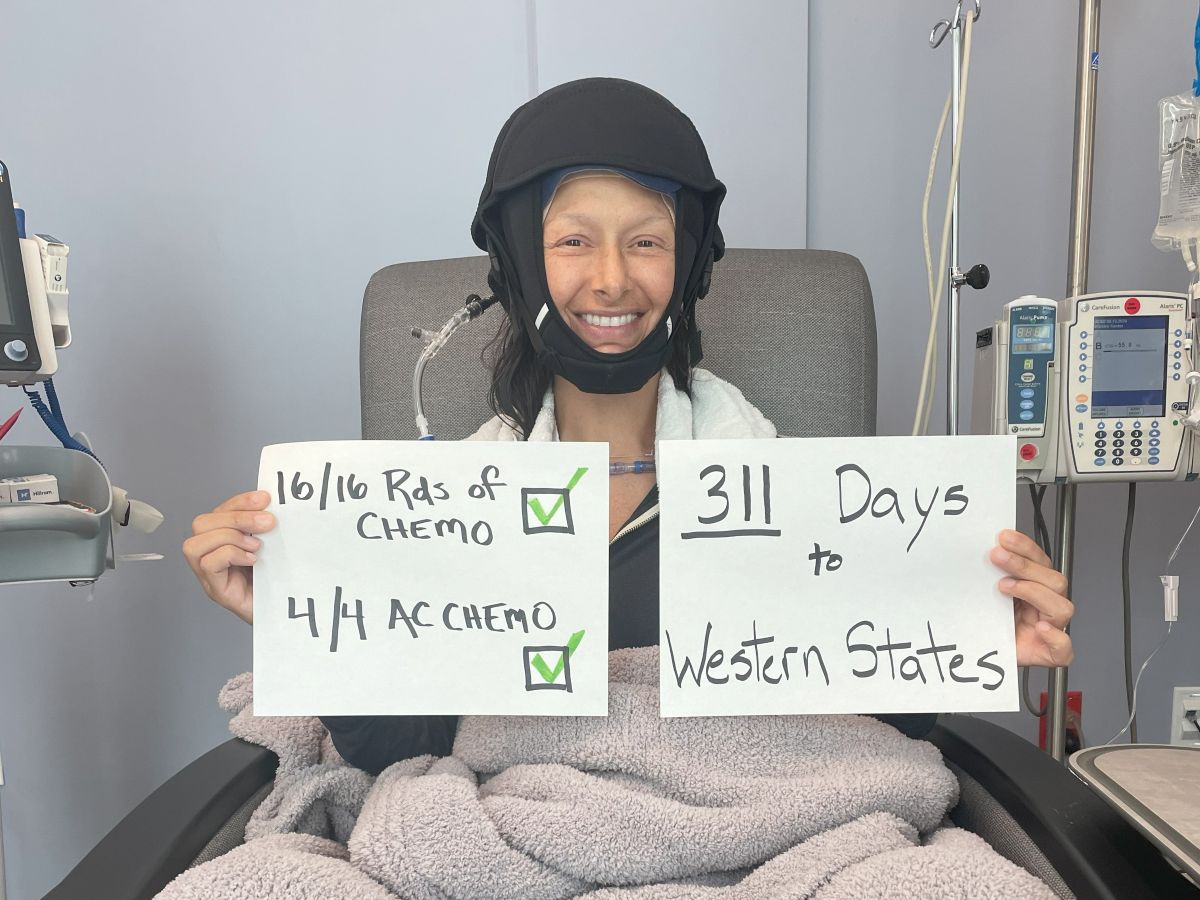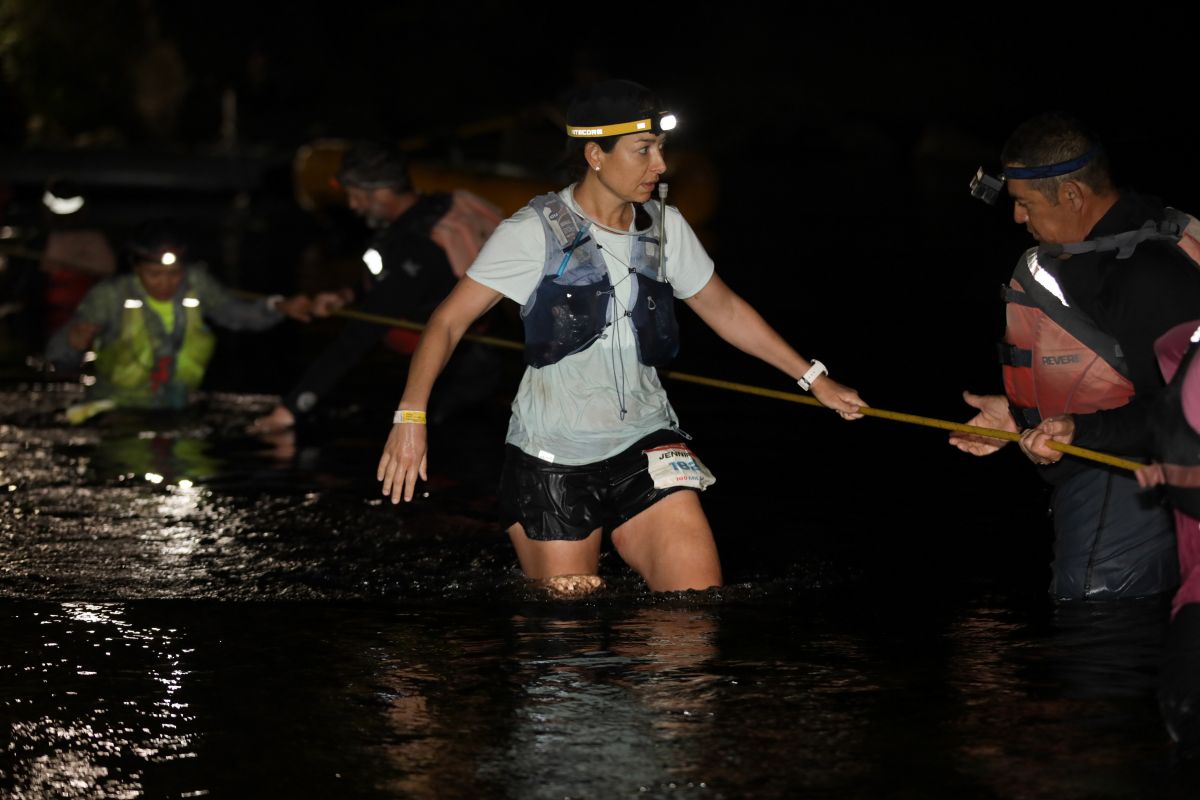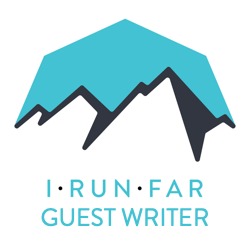[Editor’s Note: This Community Voices article was written by ultrarunner and breast cancer survivor, Jennifer George.]
“Happy Western States weekend,” she said.
I looked up, surprised to see her. My oncologist never came to my chemotherapy sessions. “It was unanimous.” My stomach knotted. She was referring to the consensus of the tumor board.
As I stand, a year later, aware of my feet planted on the ground, the clock slowly ticking down … 8, 7, 6 … I look up at the mountain directly before me, the gateway to the 100 miles I’ve fought so hard to run. I close my eyes, feel the firm leather of the chemo infusion chair, the hum of the machines saving my life, and remember. Today, I’m running over mountains. This time last year, with my oncologist, I was about to walk off a cliff.
Five, 4, 3 … I inhale a deep breath and open my eyes. The moment I’ve been patiently waiting for. The moment we worried may never come.
Two, 1. Exhale. I lift my right foot, lean forward, and run.
Unfinished Business
The last time I’d run the Western States 100 was in 2015. I often joked I’d gotten the hard things right, and the easy things wrong. My body was ready. But I came alone, with no crew and a single pacer waiting at Foresthill, mile 62 of the race. I never made it there. My heart quietly stayed broken for years — until the pull of Western States returned, soft at first, then impossible to ignore.
The first time it came back to me, I was fresh home from the hospital with my newborn daughter. It had been five years since my DNF. I looked at her — tiny, perfect — and wondered, Will I still want to run Western States? A year later, pregnant with our son, I decided: yes. Before he turned one, I ran my first 50 miler in eight years. I was on my way back.
When a heatwave derailed my first qualifier at the 2023 Cuyamaca 100k, I threw my name into the Western States donation raffle. What the hell, I thought. Two months later, on lottery day, I refreshed the page like a hopeless romantic — and there it was, may name. “Jennifer George.” The tears came fast. The joy, infinite.
Raffle winners get a year to qualify. I sealed the deal in February 2024 at the Black Canyon 100k. I was going back. My heart was healing. Or so I thought.
June 2025: Start Line to Duncan Canyon
We run under the starting line, crews and family lining the path and cheering loudly, I am surprisingly calm. Getting here had seemed impossible only months earlier, so I focus on gratitude to derail any fear of what was about to happen.
We make the right turn to begin the climb up the Escarpment, the high point of the race only a few miles in. My heart beats out of my chest. I am beginning to panic. I take deep breaths, trying to get more oxygen to my lungs. I love to climb. Is this nerves? A lingering side effect of my oral chemotherapy?
The grade finally levels out a bit, and I try to minimize the shit show happening in my chest. But I take my first Gu and gag. Are you kidding me, I think. This is way too early to be going off the tracks.
I pass my family near the tram, a little embarrassed about this early visit to the pain cave. Then the crowds of the Escarpment come into view — hundreds lining the trail, forming a tunnel to the top. I want to cry. We are here. We are in it. Jen, you can do this, I think.
Coming over the top of the Escarpment and getting onto singletrack is incredible. All of a sudden my lungs work. We settle into a purposeful pace, and find a rhythm, winding our way to Lyon Ridge at about mile 10.
We pour in and out of the first aid station, setting out on the 5.5 miles to Red Star Ridge (mile 15.5), and then 8.6 miles to Duncan Canyon (mile 24.4). I know I need to be patient in the high country. This is the hardest and highest part of the course, and my health remains compromised, so I can’t push too much here. I’ll have to make up time elsewhere.
I finally hit Duncan Canyon and see my dear friends, Jess and Mer, who at the last minute changed their flights to meet me at this aid station specifically, knowing how worried I am about the high country. I slump in the chair and say, “Yup, that was as sucky as I remember.”
Doused in ice cold wet towels, I take Pepto in hopes it will settle my stomach. But instead I lean over the edge of the chair and throw up. After three or four good empties, I apologize to those around, and proceed to throw up even more.
“Wow, I needed that.” I say, feeling much better.
More Pepto, ginger ale, and an epic sponge bath from the aid station and I am off. It’s 12:04 p.m. I have two hours and six minutes to go 5.9 miles to Robinson Flat before its cutoff. It is going to be close.
February 2024: My Cancer Diagnosis
Two weeks after locking in my Western States spot at Black Canyon, anything felt possible — until a moment in the shower when a visceral image flashed before me. Recently, a nurse practitioner friend had told me about a young mom who had ignored a lump in her breast that turned out to be Stage 4 breast cancer. Standing there in the shower, I thought, I should check myself. For her.
I checked the right side. Nothing. I checked the left side. What’s that?! A rice kernel inside my breast? I felt it again. And again. And again.
“I’m going to schedule a biopsy,” the radiologist said at an appointment not long later. The energy shifted, though I didn’t fully understand why. “You have a large mass in your breast.”
Ok, I thought. I can handle this. It’s probably benign. I’m only 39. I just crushed a 100k. It can’t be that bad.
He continued, “And your lymph nodes. They look enlarged. We’re going to biopsy those too.”
“So, if this is cancer, it could have spread?” I asked. My breath caught in my throat.
“I just want you to think about the word, ‘treatable,’” he answered.
I could feel a sob building. I pushed it down. My husband, Ben, was traveling for work at the time. I needed him. Instead, I asked the radiologist, “But if it is cancer, I caught this early, right?”
I’ll never forget the look on his face. The “rice kernel,” most certainly the only part of the lump I could actually feel, was 6.8 centimeters in diameter. In breast cancer terms, this was huge. I also had seven to eight lymph nodes that looked inflamed, as in, potentially filled with cancer. I thought of the woman in the story. Was she a warning or a premonition?
The following weeks were filled with a fear that was so suffocating, it was as if simply existing hurt. I couldn’t sleep. I was trapped in a zombie-like state of panic and fear. And Western States? Now just a cruel joke. I had two young children. Geno had just turned two and Lilly was about to turn four.
I wasn’t just losing Western States. I might be losing my life. Had I taken all this for granted?
Awaiting the biopsy results, I’d finally started to come out of the state of immobilization fear had locked me in, and made a decision. Only now I’d have to convince my family to do the same. “I want us all to agree that if the results come back anything but Stage 4, Western States remains the goal,” I told them all.
This felt selfish, crazy. My family was more than reason to want to fight. But Western States reminded me I wasn’t built just to survive. And thankfully, my family knew this about me. So, when we went to University of California, San Diego Oncology, having confirmed that both my breast and lymph nodes were positive for cancer, we were aligned.
“I think there’s a good chance you’re Stage 2. Maybe Stage 3,” the physician assistant said. It was now March 20, 2024.
“How long is this going to take?” I asked. I had 466 days to Western States. “It’s up to your medical oncologist. My guess is you’ll do chemo first, then surgery, then radiation. This is a journey. There will be a lot of ups and downs.” Ha. Telling me, an ultrarunner, about a “journey?” I gave him a knowing look.
“Nine to 12 months,” he said.
Twelve months would be out of the question. Not to mention, what shape would I be in after all of this? Would my body be able to withstand the beating it takes to prepare for a race like Western States after a year of cancer treatments?
“What’s it going to take to be done in nine?” I asked. He looked at me with hesitation, “Nothing can go wrong.”
Things started looking up as we got the results of my scans. I was most likely Stage 3 — but treatable.
Then came a sign from above. Meeting my oncologist for the first time, she pushed the curtain aside, smiled, and said, “How ’bout the Barkley Marathons?!” I nearly gasped. It was the spring of 2024 and Jasmin Paris had just become the first woman to finish. This doctor, whose hands now held both my life and hope of running Western States, had just dropped a reference to the most legendary underground race in the sport.
Jen, you will run the Western States 100! I thought.
June 2025: Duncan Canyon to Devil’s Thumb
After my phenomenal puke and rally, I have two-plus miles down to Duncan Canyon Creek, followed by the long climb to Robinson Flat, mile 30.3. As I climb, I check my watch: 12:50 p.m. I have an hour and 20 minutes to climb almost four miles and make the cutoff.
I come into Robinson Flat with less than 15 minutes to spare. I can do this, I think. I need to get some food down in order to make the best of the canyons ahead. My crew hands me cold chicken and stars soup. It is perfect. And the clock is ticking. I change into a cold, soaked cotton tee and refill my pack. I kiss my babies, then Ben, and I am on my way.
As I climb out of Robinson, I mentally prepare for the work I have ahead. I had known this cutoff would be tight, but I feel calm. I’m still on track, I think. I need to stay cool, eat, and run. After all, the canyons are by far my favorite part of this course. As we crest the top, it is on. Thirty-one miles down. Sixty-nine to go.
I make great time to Miller’s Defeat (mile 34.4), and by the time I get to Dusty Corners (mile 38), it is 3:45 p.m. I need to get to the base of Devil’s Thumb (mile 46.2) no later than 6 p.m. to give myself enough time to beat the 7:10 p.m. cutoff at the top. I have 8.2 miles and two hours, 15 minutes to get there. I take off.
As I run, I am reminded of how this course doesn’t just demand strength — it presses on every weak spot I’ve developed over the last 18 months of cancer treatment. Medically induced menopause is saving my life, but wrecking my joints and thermoregulation. Shockingly, my body is holding up. And as I drop into the final steep descent, I spot the swinging bridge at the base of Devil’s Thumb.
I look at my watch: 5:45 p.m.
I speak clearly in my head, One foot in front of the other. Do. Not. Stop. And for the first time in hours, 46-plus miles into the race, I take stock of my condition. My legs feel great.
As I am picking up momentum, Taylor Swift’s 10-minute “All Too Well” plays in my ears. I laugh out loud. There I am, on the steepest climb of the Western States 100, smiling wide, lip syncing gleefully, “cause there we are again on that little town street.”
I become emotional by thinking, If only I could’ve seen this one year ago.
April 2024: Chemotherapy Begins
On April 18, 2024, I started my first of 12 rounds of chemotherapy. I searched everywhere for stories of women who kept running through breast cancer treatment. Instead, I found the opposite. But if I had any chance of running Western States, I had to run during chemo.
The first type of chemo came with ample side effects: neuropathy, hair loss, low red and white blood cells, nausea, fatigue, bone pain, and mouth sores. The list went on.
I’d decided I’d run 20 miles a week along with three strength sessions. It would be hard. But if people thought I trained hard for races before cancer, wait until they saw me train to live.
Every week, I hit those milestones. If I had nausea? I ran. Fatigue? I ran. It wasn’t pretty, but I got it done. My tumor had shrunk. I looked strong. I started to believe I might make it out of this mildly unscathed.
June 2025: Devil’s Thumb to Foresthill
When I reach the top of Devil’s Thumb (mile 47.8), it is 6:28 p.m. I had made up 42 minutes on the cutoff. I feel triumphant. Let’s. Fucking. Go.
The next section, the descent into El Dorado Canyon, is enough to make even the best runners pray for a climb. But today, I move with ease. The sun is just starting to lower behind the peaks, and seeing Michigan Bluff in the distance fills me with hope. God, I love this course.
Before I know it, I am at the bottom, crossing the bridge to the aid station. I beeline to the creek for a quick dip before starting up the climb. We are now more than halfway, having run over 52.9 miles.
Does this climb ever get easier?! I think on the 2.5 miles out of El Dorado Canyon. Here, I first notice that I am starting to get low on calories. I am slowing down, but still moving with purpose. When I hit the last stretch of trail, then pavement, I run into Michigan Bluff (mile 55.7). I see my husband cheering at the turn and run straight into his arms. I am still 40 minutes ahead of the cutoff. “I’m going to do this!” I tell him.
It is the last beautiful glow before dark as my pacer and I set out for Foresthill (mile 62). I curse on the steep downs to Volcano Canyon, and then enjoy the climb out, which feels shockingly easier and shorter than usual. Before we know it, we hit Bath Road with a mile left to the aid.
It is now 11 p.m. I am 100 kilometers into the race and still 40 minutes ahead of the cutoffs. Despite my legs feeling great, I need a calorie boost. I eat ramen and question if another puke sesh is needed. But I look with it, feel with it, and have no need for a backup plan. I very simply need to crush this next section on Cal Street. Finally, we head off into the dark.
June 2024: Stronger Chemo Treatments
“It was unanimous.”
With roughly 365 days to toe the line, the tumor board confirmed my worst fear. I needed the stronger and more brutal A.C. chemo after all. The “Red Devil,” one of the most toxic chemos that exist. Suddenly, everything felt dark again, and Western States disappeared behind the fear of dying.
It was all I could do to keep putting one foot in front of the other. Jen, you have to do this, I thought.
June 2025: Foresthill to Cal 3
I leave Foresthill, focused on the task ahead. For months I’d thought, If I get to Foresthill, I can finish. But in the moment, 38 miles still seems far. We need to move. And to do that, I need to eat.
The downhills are starting to take more out of me. I’d lingered too long at Foresthill and didn’t leave until 11:20 p.m. Now, Cal 1 (mile 65.7) feels like it’s taking too long to get to, and we arrive at 12:18 a.m. I know the next stretch — the rollers — would demand everything I have. My stomach was officially not cooperating. Despite it being the middle of the night, and having been moving for 19-plus hours, I am more focused than ever. I drink broth, choke down a gel, and push on.
To my surprise, we make good work on those rollers, and when the Elevator Shaft comes, I run down it well.
Reaching Cal 2 (mile 70.7), I need a reset. I grab a tree and puke. My pacer jokes he’s “seen better.” We have some runnable sections coming and I need to make good use of them. I try to eat some grilled cheese and soup, and out we go.
We move well on the one-and-a-half-mile descent, but soon after, everything feels harder and slower. My stomach is betraying me. I am stopping for a bathroom break every mile. Finally, we hit Six-Minute Hill. This really sucks.
Once over the top, we hurry down to Cal 3 (mile 73). I begin doing the math in my head. We have five miles to Rucky Chucky (mile 78) and would be ahead of the 5 a.m. cutoff, no question. But now I was calculating toward the final cutoffs. Six hours to do 22 miles, after running 78 miles? This is much tighter than I’d realized. I begin to panic.
July 2024 to January 2025: Ringing the Bell
By round two of A.C. chemo, all my facial hair was gone. My scalp hair hung on, thanks to Amma, my cold cap. Standing up felt like I’d just sprinted up a mountain and I was afraid to be left alone with my own children — worried if something happened, I couldn’t lift them. Friends stepped in to help, my chemo crew.
By the third round, I could barely walk up the stairs. First, I’d try to walk around the block. Then a mile. Then three. But running felt impossible — until eight days after that third A.C. infusion.
I stood at the end of my driveway, hands on my knees, catching my breath, staring down the road. I had to try. I stood up, lifted my right foot, and leaned forward. It was ugly. And I was crying — tears of joy. When I stopped, I’d run 1.2 miles. It might as well have been the finish line at Western States.
I can do this, I thought, as tears streamed down my face.
On August 23, 2024 — 311 days to Western States — I completed my 16th and final round of chemo, having run over 315 miles during treatment. For the first time, I could no longer feel that damn rice kernel.
Six weeks later, I’d have surgery to remove my cancer, and was even more hopeful when my surgeon cleared me early to begin radiation since I was healing so well. Radio-oncology warned me of possible lifelong cardiac issues and reduced lung capacity. I was sick of hearing the word “fatigue.” But I knocked down all 30 rounds of radiation, one by one. And I kept running.
Then finally, on January 9, 2025, I rang the final bell. Eight months and 22 days later. Against all odds, we’d done it. With 170 days to Western States.
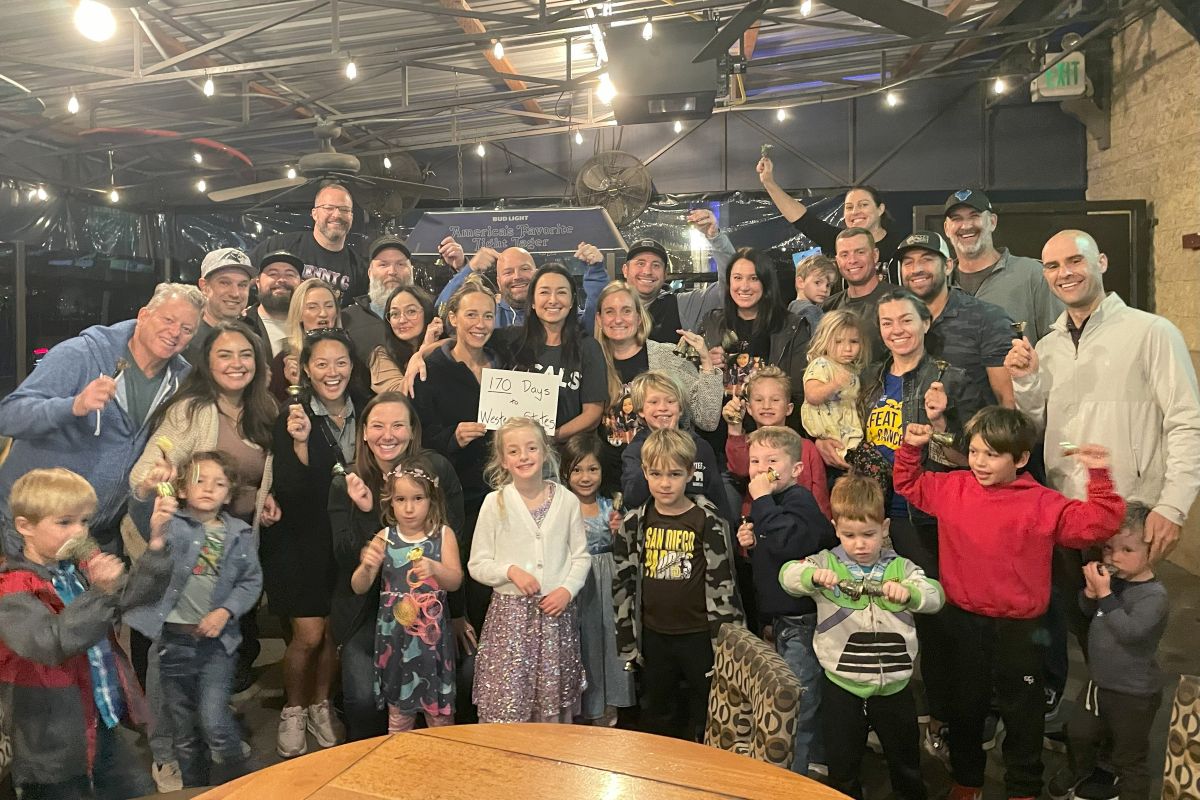
Ringing the bell to celebrate the end of radiation therapy, surrounded by friends and family, with 170 days to Western States.
June 2025: Rucky Chucky to Green Gate
Out on the trail, with only the light of our headlamps, my mind is racing. My body is ready to crush 25 more miles, except for my stomach. I have to fix this. Is it too late? Finally, a glow illuminates the darkness around the bend. It is the river crossing and I feel hope. I see the last climb, then the volunteers in the water. I’m at Rucky Chucky (mile 78) and it’s 4:29 a.m. I have 6.5 hours to go 22 miles.
I now have chafing and friction irritating me in multiple places. After a quick fix, I slump in a chair with my entire crew bearing down on me.
“16:40-minute miles,” they say, the pace I’ll need to run to make the cutoffs to come. If I wasn’t bonking, this is do-able. My legs are ready, but my stomach isn’t.
That said, quitting is not on the table. My next pacer, Brit, grabs my hand, looks me square in the eyes, and says, “We need to go. Now.”
We hold hands as we make our way down to the river. I’d dreamt of this moment so many times. Crossing this river meant I was going to finish. But being here now, my dream has never seemed further away. Would we make it? Could we make it?
We get out on the other side of the river to make the climb up to Green Gate (mile 79.8). Brit means business and having her with me is comforting. By the time we make it to the top, the sun is giving first light. I’d made it to the second sunrise, and it is overwhelmingly beautiful.
January to May 2025: Training on Empty
Now that I’d rung the final bell, Western States training was finally front and center. One obstacle still hovered — the one I’d feared from the very beginning. Capable of unraveling it all. The kind of thing you can’t out-train.
I was easing into 50-mile weeks. I’d run the Carlsbad Half Marathon after laps on my favorite mountain, and then tackled a local course with 33 miles with 9,000 feet of climbing — all in seven days.
Then, on a routine five-miler, I had to stop and walk. I was completely exhausted. I came into the garage, holding back tears, when I saw Ben. At the sight of him, I broke down. I said, “If I don’t have red blood cells, I can’t run Western States.”
The oral chemo that was getting to me. I still had 10 years of hormone therapy, and four years of oral chemo ahead. Within weeks of starting it, my pace dropped significantly. My red blood cells had tanked.
My doctor ran every test. The results, and a choice, came quickly. I could push through and hope that the adaptations would come, or stop running to allow my body to adapt more quickly. To be honest, I wanted to quit. Frustrated and pissed off, I continued “running.” I begrudgingly put one foot in front of the other. Week after week. Slowly, my body began to adapt. I wasn’t fast, but I was still moving. And in that moment, it was enough.
Between January and May, I put down six ultra efforts, including a back-to-back at the Grand Canyon of Rim-to-Rim-to-Rim and Rim-to-River-to-Rim, more than 40 miles one day and 20 the next. Somewhere on the South Rim, I realized: I wasn’t just surviving anymore. I was fighting. I don’t need speed to finish Western States, I thought. I just need to keep moving.
June 2025: Green Gate to Auburn Lake Trails
At Green Gate, tensions are high, and full daylight is back. We have over 5.5 miles to Auburn Lake Trails (mile 85.5) — and this isn’t how I’d envisioned this section.
The urgency is palpable. Everyone around us is moving quickly. I make good work of the first mile — Brit even has to run to catch up. But the farther we get from Green Gate, the more depleted I become. Brit urges me to move faster. I am scraping the bottom of the barrel.
Every time I toe the line of an ultra, I wonder: How much can I suffer? Yesterday and today, I’ve answered that — defiantly. I am not afraid of the pain cave. I just have no gas in the tank.
Brit continues to plead with me to move faster. Each time, I say, “I love you,” and she says it back. It is 6:45 a.m. I’ve been running for 25 hours and 45 minutes. Unfortunately, the clock is now moving faster than me.
We pass a memorial on our left. “I think this means we’re close?” I sat. It is 7 a.m. We have 10 minutes to beat the cutoff at Auburn Lake Trails aid station. We can do this, I say to myself as I run. Hope is building. I am envisioning how I’ll move through the aid station. But just as we see the aid in the distance, we hear the horn announcing the cutoff. My Western States journey is over.
We don’t stop moving. Not until we reach the aid station and I sink into a chair — utterly spent after 26 hours and 20 minutes, and 85.5 miles. There are no tears. No regret. To my surprise, the emotion that overwhelms me is gratitude.
Gratitude for the chance to feel this broken. To have chased something so hard, it wrecked me. For the thread Western States had become — the one I clung to when everything else was unraveling. When cancer tried to take everything, this dream became my purpose and reminded me to notice life again. Even the little things. Especially the little things.
The Trail That Hope Carves
I used to believe we honored those still waiting for their Western States moment by crossing the finish line — that the buckle made our journeys worthy. But cancer taught me that the deepest honoring comes from toeing the line with a heart that dares to dream.
The truth is, none of us are promised a finish — not the elites, not the fighters, not anyone. And when we don’t get there, when we fall short, we carry something heavier than regret. We carry the beginning of something new.
We don’t leave empty-handed. We leave changed.
And somewhere deep down, we know: This wasn’t the end. It was the becoming.
Because even bigger than the finish, of any race or obstacle that life presents, is the journey — and the trail that hope quietly carves as we go.
Call for Comments
- Did you see Jennifer at the 2025 Western States 100? How inspired were you by her story?
- Have you used running or a goal race to help you get through a major obstacle in your life?


